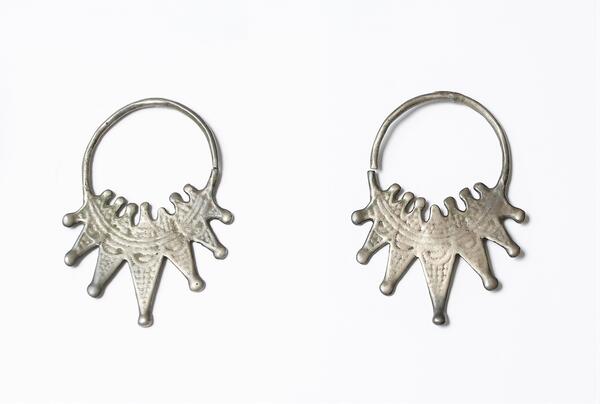Temple rings are women’s jewelry; in ancient times, they were fastened on top of a headdress, a scarf, ribbons, or straps near temples. They were made of silver, bronze, or gold and could be worn one pair or more at a time.
This kind of jewelry has been known since the Bronze Age. The first rings were made of bronze in the form of spirals. Researchers date such rings to the 3th — 4th centuries BC and attribute them to the Trypillia culture. In the Eneolithic and Early Bronze Age, it existed on the territories of Moldova, in the forest-steppe and steppe zones of Ukraine, and to the west of the Dnieper River valley.
By the 8th — 9th centuries AD, the temple rings appeared in all Western Slavic tribes, which became the reason why they were considered typical Slavic jewelry. Gradually, the fashion for them reached the Eastern Slavs as well.
In different tribes, the shape of temple rings and ways of wearing them was different. Ornaments were made in the form of rays, rhombuses, spirals, and beads. Rings could be suspended from a headdress on ribbons or straps framing the face. Sometimes they were put into lanyards and ribbons, fastened to the hair, or put into an earlobe.
In the 10th — 12th centuries, seven-rayed rings, such as the rings displayed at the exhibition, were found in different regions of Russia. But they were most popular among the descendants of Radimichi — a tribal union that lived between the Dnieper and Desna rivers. On this territory, they were made in a simplified form. At the end of the 11th — 12th centuries, similar seven-lobed rings appeared in the neighboring tribe — Vyatichi.
In the 12th — 13th centuries, temple rings increased in size, and the patterns and ornaments they were decorated with became more complicated. At the base of such items was a ring — a hoop. Several prongs were set on the bottom, directed inwards. Several triangular rays diverged from the lower part of the piece.
All temple rings had some similar features: they were made of silver with pronounced ear backs. The plate was a part of a piece to which prongs and rays were fastened; the ends of rays were decorated with granules — small gold or silver balls. False granules, made of wire, could also be placed on the end of each ray.
Nowadays, all known seven-rayed temple rings are divided into three main types. The pieces with a smooth plate are considered to be classic ones. The second type includes temple rings with five prongs on the upper edge of the plate. The third “Desninsky” type has trefoil-shaped rays, and the plate is decorated with ornaments.
The rings housed in the museum’s collection may be attributed to the third type. They have seven prongs on the edge of the plate, and the rays end in a drop-shaped granules. The plate has an ornament of convex semicircles that visually separate it from the rays. The hoop merges almost unnoticeably into the plate.
This kind of jewelry has been known since the Bronze Age. The first rings were made of bronze in the form of spirals. Researchers date such rings to the 3th — 4th centuries BC and attribute them to the Trypillia culture. In the Eneolithic and Early Bronze Age, it existed on the territories of Moldova, in the forest-steppe and steppe zones of Ukraine, and to the west of the Dnieper River valley.
By the 8th — 9th centuries AD, the temple rings appeared in all Western Slavic tribes, which became the reason why they were considered typical Slavic jewelry. Gradually, the fashion for them reached the Eastern Slavs as well.
In different tribes, the shape of temple rings and ways of wearing them was different. Ornaments were made in the form of rays, rhombuses, spirals, and beads. Rings could be suspended from a headdress on ribbons or straps framing the face. Sometimes they were put into lanyards and ribbons, fastened to the hair, or put into an earlobe.
In the 10th — 12th centuries, seven-rayed rings, such as the rings displayed at the exhibition, were found in different regions of Russia. But they were most popular among the descendants of Radimichi — a tribal union that lived between the Dnieper and Desna rivers. On this territory, they were made in a simplified form. At the end of the 11th — 12th centuries, similar seven-lobed rings appeared in the neighboring tribe — Vyatichi.
In the 12th — 13th centuries, temple rings increased in size, and the patterns and ornaments they were decorated with became more complicated. At the base of such items was a ring — a hoop. Several prongs were set on the bottom, directed inwards. Several triangular rays diverged from the lower part of the piece.
All temple rings had some similar features: they were made of silver with pronounced ear backs. The plate was a part of a piece to which prongs and rays were fastened; the ends of rays were decorated with granules — small gold or silver balls. False granules, made of wire, could also be placed on the end of each ray.
Nowadays, all known seven-rayed temple rings are divided into three main types. The pieces with a smooth plate are considered to be classic ones. The second type includes temple rings with five prongs on the upper edge of the plate. The third “Desninsky” type has trefoil-shaped rays, and the plate is decorated with ornaments.
The rings housed in the museum’s collection may be attributed to the third type. They have seven prongs on the edge of the plate, and the rays end in a drop-shaped granules. The plate has an ornament of convex semicircles that visually separate it from the rays. The hoop merges almost unnoticeably into the plate.



